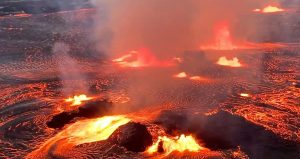Hawaiian Eruptions Since 2018: Kilauea and Mauna Loa Volcanoes
Presented by Robert I. Tilling, Volcanologist Emeritus, U.S. Geological Survey (USGS)
September 5th (Tuesday), 6 p.m., ***NEW: Social half-hour, please join us from 5:30-6:00 to enjoy free soft drinks and appetizers before our talk begins!***
Live at the Teton County Library & Via Zoom (online)
Hawaiian volcanoes are among the most active in the world. Their eruptions and dynamics have been closely studied by staff of the USGS Hawaiian Volcano Observatory (HVO) and other volcanologists for many decades. Since the early 1980s, Kilauea Volcano has been almost continuously active and involved: 1) the January 1983-April 2018 eruption at Pu’u ‘O’o and nearby vents in its Middle East Rift Zone (MERZ); 2) an active lava lake during 2008-2018 in Halemaumau Crater at the summit caldera; and 3) a short-lived eruption beginning in May 2018 in its lower East Rift Zone (LERZ). Though lasting only four months, the 2018 LERZ eruption was Kilauea’s most voluminous, and most destructive, LERZ eruption during the past 200 years. This eruption resulted in the evacuation of ~2,000 residents, destruction of more than 700 dwellings, and burial of ~ 30 miles of roads by lava.
When the 2018 LERZ eruption ended in early September, Kilauea became quiet and exhibited no active lava for about two years. Then in late December 2020, lava erupted once again within Halemaumau Crater, to initiate several summit eruptions of variable durations and pauses separating them: December 2020-May 2021; September 2021-December 2022; January-March 2023; and June 2023. During this time of recurring Kilauea summit activity, an eruption began near midnight of 27 November 2022 within the summit caldera of Mauna Loa Volcano (quiescent since 1984), in a rare occurrence of simultaneous eruptive activity at both Kilauea and Mauna Loa. Fortunately, the 2022 Mauna Loa eruption was brief (ending on 10 December) and posed no serious threats to populated areas.
Since 2018, five years of frequent eruptive activity have provided HVO and other volcanologists ample opportunities to study phenomena associated with classic Hawaiian volcanism, using round-the-clock monitoring techniques. The abundant new data now available are refining our understanding of how Hawaiian volcanoes work. In his public lecture, Bob Tilling will present some highlights—complemented by video clips—of the post-2018 Hawaiian eruptions, focusing in particular on the dynamics of active lava lakes.
Night-time view from the caldera rim of the vigorous lava-lake activity within Halemaumau Crater at summit of Kilauea Volcano on 7 June 2023 (credit USGS). The eruption ended on 19 June, 2023.
Topic: Hawaiian Eruptions Since 2018: Kilauea and Mauna Loa Volcanoes
Time: Tuesday September 5th, 2023 06:00 PM Mountain Time (US and Canada)
Join Zoom Meeting
https://us02web.zoom.us/j/4555651818?pwd=U09ObDNZOEIyZmRtMEtsdUowQnJqdz09
Meeting ID: 455 565 1818
Passcode: 576063

